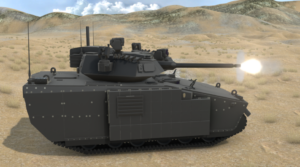BAE Systems on Wednesday offered its most extensive insight to date on its proposal for the Army’s Optionally Manned Fighting Vehicle (OMFV) competition, detailing its 50-ton, hybrid-electric offering, which it says is designed to maximize modularity and features a new Elbit Systems of America
-supplied turret.
Jim Miller, BAE Systems’ vice president of business development, told reporters the Army’s iterative design approach with industry has been a key enabler for the Bradley replacement program and cited the company’s decision to go with a purpose-built design as key to meeting requirements for future vehicle growth.

“We thought that was pretty important given the Army’s requirements and where they’re headed with this to go with a new design, a new vehicle. We didn’t see an existing vehicle that had the space or the growth. So it has to be a new design, in our view,” Miller said during a briefing on the company’s OMFV offering. “[Infantry Fighting Vehicles] are in service for a long time, decades and decades. You have to start with a vehicle that can grow and adapt to new threats, new technologies. And if you’re not creating that for the Army, you’re not doing what they want.”
BAE Systems was one of five firms the Army selected last July, along with General Dynamics Land Systems [GD], Oshkosh Defense [OSK], American Rheinmetall Vehicles and armor supplier Point Blank Enterprises, to participate in the current concept refinement phase for the OMFV program. (Defense Daily, July 23 2021).
All five competitors recently submitted proposals for the competition’s upcoming detailed design and prototype build phases, with the Army planning to award up to three contracts for OMFV Phases 3 and 4 that will culminate in selected vendors each delivering up to 11 prototype vehicles (Defense Daily, Nov. 4).
“We feel pretty confident that given the choice of us and our competitors, we have the experiences necessary to drive this program forward,” Miller said. “The experience that we have with IFVs is unmatched. So Bradley has given us that in the United States for years and years.”
BAE Systems on Wednesday also detailed the key contributions from its top partners on OMFV, to include Elbit America and its new 50mm Unmanned Turret (UT50) as well as QinetiQ supporting the design’s hybrid-electric drive technology and Curtiss-Wright [CW] working on the platform’s modular vehicle architecture.
William Nuckols, Elbit America’s senior director for capture, said the company developed the UT50 as part of a Cooperative Research and Development Agreement with the Army’s DEVCOM Armaments Center, which included a demonstration in September that featured firing “well over 200 rounds, including key ranges out to 2,500-3,000 meters.”
“Our turret…frankly represents a dramatic shift in infantry fighting vehicle lethality and soldier survivability. The centerpiece of the UT50 is a fully-integrated U.S. Army-designed and Northrop Grumman [NOC]-built XM913 50mm cannon. The XM913 and its suite of ammunition represents a significant increase in lethality and, frankly, provides the U.S. Army soldier with tactical overmatch relative to any potential future adversary,” Nuckols told reporters.
Mike Stewart, QinetiQ’s group chief technology officer, said his company has been collaborating with BAE Systems on hybrid-electric technologies for over 20 years, to now include supporting the OMFV design’s series hybrid-electric drive with its E-X-Drive transmission.
“What we have is essentially a power-dense electromechanical cross drive transmission. And really that’s designed to be part of either a hybrid or a fully-electrical power train,” Stewart said. “This is a scalable technology. It can be designed for different weight classes. But we’ve custom designed it for the OMFV offering here.”
Miller said the hybrid-electric drive provides the OMFV offering with nine hours of silent watch capability, 2.5 kilometers of silent maneuver while surpassing the Army’s base requirement for mobility and meeting the objective levels laid out in the requirements.
“We think the series hybrid-electric drive gives you the drive, the mobility, the burst speed, the torque to be able to operate anywhere that you choose to operate,” Miller said.
In October, Miller told Defense Daily that BAE Systems is planning to build all future combat vehicles with capability for hybrid-electric power (Defense Daily, Oct. 11).
BAE Systems noted it has 500 hours of testing with the hybrid-electric drive from its current effort providing two prototype Bradleys outfitted with the system for an Army research and development effort.
Doug Bush, the Army’s top acquisition official, said earlier this month he “fully expects” OMFV will be a hybrid-electric powered platform “based on [vendors’] bids so far, the direction of technology and the Army’s goals” that it gave to the contractors competing for the program (Defense Daily, Nov. 4).
Jacob Sealander, Curtiss-Wright’s chief architect for C5ISR Systems’ business development, detailed the company’s approach to supporting the modular open systems architecture (MOSA) for BAE Systems’ OMFV design, which he said will enable “quick reaction to evolving threats, ease of system upgrades, reduced vendor lock.”
“Curtiss-Wright’s involvement in the team is to really, from the ground up, work with all of the partners to say how do we take these, again, paradigm shift requirements…and say how does it impact not only the architecture itself but the digital engineering environment and its design,” Sealander said. “As the Army has said, MOSA is a law. It’s not a suggestion”
BAE Systems also noted its offering also features the Iron Fist active protection system and a multi-mission missile launcher, and noted its offering meets the Army’s call for a two-man crew with a digital architecture bringing in artificial intelligence systems and aided target recognition capabilities.
“The digital architecture, artificial intelligence, [aided] target recognition, it’s going to help that two-man crew do its job. And, of course, that automation is going to reduce what the Army has called the cognitive impact on the soldiers,” Miller said.